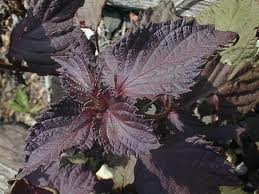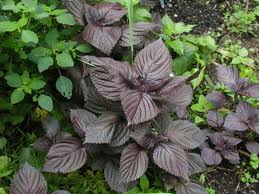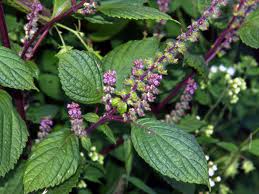Site Menu:
| This is an archived Horseadvice.com Discussion. The parent article and menus are available on the navigation menu below: |
| HorseAdvice.com » Diseases of Horses » Poisons , Venoms & Poisonous Plants » Poisons, Poisonous Plants, and Venomous Animals » |
| Discussion on Perilla Mint Toxicosis | |
| Author | Message |
| New Member: star010 |
Posted on Friday, Jun 10, 2011 - 5:08 pm: we have 6 horses who have displayed breathing difficulties. Two of them for several years, 2 of them for the past couple of years and 2 more recently. We have had vets out over the years for this specific problem, we have always been told its pasture heaves, we kept telling them we didn't think so. Now that our 2 year old has developed the same symptoms they finally listened to us and went looking and in one of the pastures they found a toxic weed. We had never heard of it before till then. It highly toxic to cattle, sheep and horses, it causes inflamation in the lungs which is made worse by the heat. The horses who are in the worst condition are being treated with ventipulmin and a breathing treatment with a mask over their nose and mouth and each receives 8 puffs once a day now. the others are all receiving the ventipulmin and are on steroid pills once daily. We so far have been able to find only very limited information on this and the best way to treat them. We are in contact with someone who is going to come out and going to use a rise beam on them and a cold laser for more targeted therapy on their lungs. We will not do anything which may cause more harm than has already been done and hopefully will help. We live in Tennessee, it grows very prolifically here in this state and is the cause of more cattle deaths here than anywhere else yet we knew nothing of this. Has anyone ever experienced anything like this? What kind of treatment did you do and how successful was it? |
| Member: paul303 |
Posted on Saturday, Jun 11, 2011 - 12:29 am: So sorry to hear of your problem. Are you getting rid of these weeds in your pasture? I had an awful problem with white clover that took 2 years to pinpoint. My horses were getting sicker and sicker ( but would clear up entirely in winter when the pasture was closed ). I did all kinds of research - I forget what got me to the clover - then pulled the horses off the pasture and had it sprayed for weeds. I haven't had a problem since, but I have my pasture sprayed each spring. If there is an outbreak of clover, I spot treat it and close that section off.I also know what treating any kind of COPD in horses is like. I wish you the best of luck, and hope you will keep us informed on your progress. |
| Member: vickiann |
Posted on Saturday, Jun 11, 2011 - 2:55 pm: So sorry to hear about this difficulty.Thanks so very much for sharing this information |
| Moderator: DrO |
Posted on Saturday, Jun 11, 2011 - 4:16 pm: Welcome Nancy,I am sorry to hear about your horses. I have not heard of Perilla or Purple Mint (Perillla frutescens) poisoning. I got this information off the UGA web site: Toxin: Perilla ketone, a 3-substituted furan similar to 4-ipomeanol. History: Seen sporadically usually in late summer or fall after grazing plant. Clinical Signs: Similar to 4-ipomeanol or 3-methyl indole, perilla ketone causes respiratory distress. Clinical signs include difficulty breathing, especially when exhaling (affected animal may grunt when exhaling). Nasal discharge, cyanosis, frothy hypersalivation, increased lung sounds. Mechanism of action: Mixed function oxidases in the lung bioactivate the perilla ketone to reactive intermediates that bind to tissue macromolecules causing pulmonary cellular destruction. Type I alveolar cells are preferentially destroyed leading to proliferation of Type II alveolar cells and ultimately pulmonary fibrosis. Pulmonary emphysema, edema and congestion can be seen on post-mortem exam. Treatment and prevention: No specific antidote. Once clinical signs are seen course of disease is difficult to reverse. Supportive care may include administration of steroids, antihistamines and antibiotics. Prevention involves eliminating plant in areas where animals graze. And from the Tennesee Extension site: "Watch out for Perilla Mint this Fall" Poisonous plants cause significant losses in the livestock industry each year due to decreased production, reproductive problems, and animal death. It is important that livestock owners are able to recognize these potentially harmful plants, in order to be in a position to avoid potential problems. In general, most poisonous plants are not very palatable and if given a choice, animals will not consume them. Factors that increase the likelihood of animal poisoning from plants include lack of good forage, deficient ration, and over fertilization of nitrogen. One of the most dangerous poisonous weeds in Tennessee pastures is perilla mint. Perilla mint causes more cattle deaths in Tennessee than any other toxic plant. Perilla is very poisonous to cattle and other ruminants, as well as horses. All plant parts are toxic, especially the flowering structures. Dried plants in hay can be toxic, but the greatest risk is associated with consumption of fresh plant material, especially if flowers and fruit are present. Cases of poisoning from these weeds are a concern during the late summer and early falls when other grasses and forages might be in short supply and the perilla mint is flowering. Cattle will normally not feed on these toxic weeds unless there is a shortage of other feed. Therefore, it is crucial to have a ready supply of quality feed available for farm animals during this time of the year. Cases of animal poisoning from consuming perilla mint are usually seen in late summer and early fall after grazing of the plant. Cattle, horses, and sheep are the most commonly affected animals. Affected animals will exhibit signs of respiratory distress. Clinical signs include labored breathing, a grunting sound when exhaling, and possible nasal discharge and elevated temperature. Once these symptoms begin to appear, treatment is usually ineffective. Injections of antihistamines, steroids, and antibiotics may be given. Affected animals should be handled gently to prevent further respiratory complications. The best time to scout for and control perilla mint is late April to early June. The distinctive minty odor and oval, green to purple leaves with toothed margins are all characteristics that help in the identification of perilla mint. It is very difficult to control perilla mint in late summer and early fall when it also becomes the most dangerous to livestock. If control measures are not taken early, it becomes even more crucial in late summer to maintain an adequate supply of quality feed for cattle and other farm animals so they will not feed on these toxic weeds. To avoid toxicity problems, avoid harvesting forages in areas contaminated with perilla mint. Mowing perilla mint plants before seed is produced will help prevent further reproduction and spread. Several of the broadleaf pasture herbicides, such as Weedmaster, Grazon P+D, 2,4- D, Banvel, Remedy, Crossbow, etc. should provide excellent control if applied timely and at the correct rate. If you have any questions regarding perilla mint or any other poisonous plant, feel free to call me at the University of Tennessee Extension office at 931-946-2435. I was sad to see that both of these note that the lung damage is mostly permanent and treatment often ineffective. I am going to edit out article on heaves to include a warning about this plant. One problem I have run into is that images of the plant are inconsistent and it seems two different looking plants are often identified as Perilla frutescens. Below our images I have found of three different varieties but the inflorescence on the green variety below looks the same on all the varieties. However the distinctive minty odor should be a key to identifying it. I am hoping your post here will prevent others from having problems. DrO |
| Moderator: DrO |
Posted on Sunday, Jun 12, 2011 - 8:15 am: The distinctive minty odor and oval, green to purple leaves with toothed margins are all characteristics that help in the identification of perilla mint.Images of Perilla frutescens:   
|
| Member: vickiann |
Posted on Sunday, Jun 12, 2011 - 5:07 pm: Thanks for posting the additional photos, Dr. O. By seeing the last one I believe that there may be some of this in my Florida pasture and it does have a minty odor. Fortunately the horses do not seem to eat it. (Right now I'm in Virginia with my horses fighting other toxic weeds). |
| Member: annes |
Posted on Wednesday, Jun 15, 2011 - 3:25 pm: I am in NW TN and perilla mint thrives on our farm mostly in shady places along fence rows and barns. We are always mowing it down. Thankfully my horses have never gotten into it but one cow almost died last February. The vet was so sure she was going to die that he had us take her week old calf away to bottle feed. We gave the cow daily shots of steroids and antibiotics and each day she improved a little bit. Her symptoms were labored breathing, swelling over her neck and chest and nasal discharge pouring from her nose. It was a miracle she lived - she was able to start nursing her calf again after 10 days. Please everyone be careful of this plant! We never knew it was toxic until this happened. It is evidently imperative to catch it early when symptoms first appear - I am sure that is what saved our cow. |
| Moderator: DrO |
Posted on Thursday, Jun 16, 2011 - 8:18 am: Ann, are the perilla leaves present in February in TN? I would have thought it dormant at that time. The description of perilla toxicosis suggests nasal discharge may be present but the copious nasal discharge in your case sounds like Bovine Rhinotracheitis, possibly complicated by a secondary bacterial pneumonia.DrO |
| Member: annes |
Posted on Thursday, Jun 16, 2011 - 12:44 pm: The vet went looking for the plant where the cow had her calf and he recognized the plant all over the area even though it was dried-up plants at that time of year. We guessed the cow ate it during the time she was "hiding out" with her new calf and not going to the hay roll and feeder to eat. The vet seemed pretty sure perilla mint was the cause but said he couldn't know for sure. The shots he gave her were the only thing he knew to do. She never lost her appetite and no other cows got sick. I will add that last summer the same vet told me one farm had 8 cows to die because the farm owner had sprayed roundup on the perilla mint. They thought the roundup made the plant more tasty to the cows and they all died after being attracted to it. My husband was just getting ready to use roundup on our perilla mint so we barely missed making that mistake. I cringe every time I see the plant but it is impossible to totally eliminate. We continue mowing it down as best we can and so far have been ok. I would rather be overly cautious now that I know what it can do. |
| New Member: ladyjane |
Posted on Tuesday, Nov 8, 2011 - 12:54 pm: Ran across these posts in my research. It seems I'm dealing with a case of perilla mint poisoning as well. My mare appeared saturday with no fever, good appetite, but very rapid breathing and pulse. The vet did an ultrasound and listened carefully to the lungs and found a little but of consolidation on the left side, but seemingly normal on the right side. All bloodwork came back as normal.She's now on a steady diet of tucoprim, ventipulmin, dexamethasone, and banamine. We started treating her Sunday afternoon and there was no improvement as of last night. About to head out now to check on her. The vet walked out tot he pasture and found ample perilla mint. I had never heard of it, nor had my barn owner. I'm interested to know if you all have discovered any more on this or have additional treatment thoughts. I'm not encouraged by most of what I've read regarding prognosis. Will keep you posted. |
| Member: vickiann |
Posted on Tuesday, Nov 8, 2011 - 2:44 pm: Have had horses attracted to weeds that my husband sprayed with Round Up where they had not been interested in them previously so had to pull the wilting things up by hand.Spraying with Round Up does seem to make things more palatable for some reason. |
| Moderator: DrO |
Posted on Wednesday, Nov 9, 2011 - 2:07 pm: Welcome Kate,I am afraid I have nothing to add to above. What is your horses respiratory rate and character? DrO |
| New Member: ladyjane |
Posted on Thursday, Nov 10, 2011 - 10:15 pm: Thanks, Vicki. We've taken the horses off the pasture with the offending plants. It does seem to thrive in the shady, damp paddocks. The sunnier, drier paddocks don't have it. Given the time of year, we're going to wait for the first couple of freezes (tonight will be our first), then scout out the pasture in the early spring for new growth.My mare is significantly improved. She is seemingly back to normal now, though still on corticosteroids. We're switching tomorrow from dexamethasone to prednisolone tabs at a decreasing dose over the next several weeks. Dr. O, initially both her respiratory and heart rates were about 60. She was essentially panting and only very occasionally would take a deep breath. Otherwise she seemed normal. |
| Moderator: DrO |
Posted on Saturday, Nov 12, 2011 - 12:12 pm: Kate, the complete recovery when treated with steroids is more consistent with Heaves (RAO) than Perilla. RAO is a very common problem of horses and will need management changes on your part to prevent recurrence. Just to be sure you have all the bases covered see HorseAdvice.com » Diseases of Horses » Respiratory System » Heaves & Chronic Obstructive Pulmonary Disease.DrO |
Horseadvice.com
is The Horseman's Advisor
Helping Thousands of Equestrians, Farriers, and Veterinarians Every Day
All rights reserved, © 1997 -
is The Horseman's Advisor
Helping Thousands of Equestrians, Farriers, and Veterinarians Every Day
All rights reserved, © 1997 -
